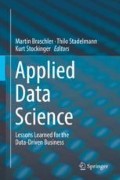Abstract
Successful demand planning relies on accurate demand forecasts. Existing demand planning software typically employs (univariate) time series models for this purpose. These methods work well if the demand of a product follows regular patterns. Their power and accuracy are, however, limited if the patterns are disturbed and the demand is driven by irregular external factors such as promotions, events, or weather conditions. Hence, modern machine-learning-based approaches take into account external drivers for improved forecasting and combine various forecasting approaches with situation-dependent strengths. Yet, to substantiate the strength and the impact of single or new methodologies, one is left with the question how to measure and compare the performance or accuracy of different forecasting methods. Standard measures such as root mean square error (RMSE) and mean absolute percentage error (MAPE) may allow for ranking the methods according to their accuracy, but in many cases these measures are difficult to interpret or the rankings are incoherent among different measures. Moreover, the impact of forecasting inaccuracies is usually not reflected by standard measures. In this chapter, we discuss this issue using the example of forecasting the demand of food products. Furthermore, we define alternative measures that provide intuitive guidance for decision makers and users of demand forecasting.
Access this chapter
Tax calculation will be finalised at checkout
Purchases are for personal use only
Preview
Unable to display preview. Download preview PDF.
References
Bajari, P., Nekipelov, D., Ryan, S., & Yang, M. (2014). Machine learning methods for demand estimation. American Economic Review, Papers and Proceedings, 105(5), 481–485.
Brown, R. (1967). Decision rules for inventory management. New York: Reinhart and Winston.
Da Veiga, C. P., Da Veiga, C. R. P., Catapan, A., Tortato, U., & Da Silva, W. V. (2014). Demand forecasting in food retail: A comparison between the Holt-Winters and ARIMA models. WSEAS Transactions on Business and Economics, 11, 608–614.
De Gooijer, J. G., & Hyndman, R. J. (2006). 25 years of time series forecasting. International Journal of Forecasting, 22, 443–473.
Doganis, P., Alexandridis, A., Patrinos, P., & Sarimveis, H. (2006). Time series sales forecasting for short shelf-life food products based on artificial neural networks and evolutionary computing. Journal of Food Engineering, 75(2), 196–204.
Hyndman, R. J. (2006). Another look at forecast-accuracy metrics for intermittent demand. Foresight, 4, 43–46.
Kolassa, S., & Schütz, W. (2007). Advantages of the MAD/Mean ratio over the MAPE. Foresight: The International Journal of Applied Forecasting, 6(6), 40–43.
Taylor, J. W. (2007). Forecasting daily supermarket sales using exponentially weighted quantile regression. European Journal of Operational Research, 178(1), 154–167.
Vasumathi, B., & Shanmuga Ranjani, S. P. (2013). Forecasting in SAP-SCM (Supply Chain Management). International Journal of Computer Science and Mobile Computing, 2(7), 114–119.
Žliobaitė, I., Bakker, J., & Pechenizkiy, M. (2012). Beating the baseline prediction in food sales: How intelligent an intelligent predictor is? Expert Systems with Applications, 39(1), 806–815.
Author information
Authors and Affiliations
Corresponding author
Editor information
Editors and Affiliations
Rights and permissions
Copyright information
© 2019 Springer Nature Switzerland AG
About this chapter
Cite this chapter
Ott, T., Glüge, S., Bödi, R., Kauf, P. (2019). Economic Measures of Forecast Accuracy for Demand Planning: A Case-Based Discussion. In: Braschler, M., Stadelmann, T., Stockinger, K. (eds) Applied Data Science. Springer, Cham. https://doi.org/10.1007/978-3-030-11821-1_20
Download citation
DOI: https://doi.org/10.1007/978-3-030-11821-1_20
Published:
Publisher Name: Springer, Cham
Print ISBN: 978-3-030-11820-4
Online ISBN: 978-3-030-11821-1
eBook Packages: Computer ScienceComputer Science (R0)

